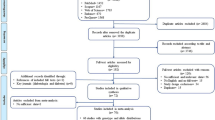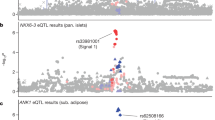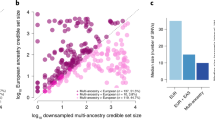Abstract
Genetic association studies are viewed as problematic and plagued by irreproducibility1. Many associations have been reported for type 2 diabetes2,3,4,5,6,7,8,9,10,11,12,13,14,15,16,17, but none have been confirmed in multiple samples and with comprehensive controls. We evaluated 16 published genetic associations to type 2 diabetes and related sub-phenotypes using a family-based design to control for population stratification, and replication samples to increase power. We were able to confirm only one association, that of the common Pro12Ala polymorphism in peroxisome proliferator-activated receptor-γ (PPARγ) with type 2 diabetes. By analysing over 3,000 individuals, we found a modest (1.25-fold) but significant (P=0.002) increase in diabetes risk associated with the more common proline allele (∼85% frequency). Moreover, our results resolve a controversy about common variation in PPARγ. An initial study found a threefold effect12, but four of five subsequent publications18,19,20,21,22 failed to confirm the association. All six studies are consistent with the odds ratio we describe. The data implicate inherited variation in PPARγ in the pathogenesis of type 2 diabetes. Because the risk allele occurs at such high frequency, its modest effect translates into a large population attributable risk—influencing as much as 25% of type 2 diabetes in the general population.
This is a preview of subscription content, access via your institution
Access options
Subscribe to this journal
Receive 12 print issues and online access
$209.00 per year
only $17.42 per issue
Buy this article
- Purchase on Springer Link
- Instant access to full article PDF
Prices may be subject to local taxes which are calculated during checkout

Similar content being viewed by others
References
Editorial. Freely associating. Nature Genet. 22, 1–2 (1999).
Almind, K. et al. Aminoacid polymorphisms of insulin receptor substrate-1 in non-insulin- dependent diabetes mellitus. Lancet 342, 828–832 (1993).
Widen, E. et al. Association of a polymorphism in the β 3-adrenergic-receptor gene with features of the insulin resistance syndrome in Finns. N. Engl. J. Med. 333, 348–351 (1995).
Baier, L.J. et al. An amino acid substitution in the human intestinal fatty acid binding protein is associated with increased fatty acid binding, increased fat oxidation, and insulin resistance. J. Clin. Invest. 95, 1281–1287 (1995).
Hager, J. et al. A missense mutation in the glucagon receptor gene is associated with non-insulin-dependent diabetes mellitus. Nature Genet. 9, 299–304 (1995).
Kan, M. et al. Frequency of mutations of insulin receptor gene in Japanese patients with NIDDM. Diabetes 44, 1081–1086 (1995).
Sakagashira, S. et al. Missense mutation of amylin gene (S20G) in Japanese NIDDM patients. Diabetes 45, 1279–1281 (1996).
Sigal, R.J., Doria, A., Warram, J.H. & Krolewski, A.S. Codon 972 polymorphism in the insulin receptor substrate-1 gene, obesity, and risk of noninsulin-dependent diabetes mellitus. J. Clin. Endocrinol. Metab. 81, 1657–1659 (1996).
Inoue, H. et al. Sequence variants in the sulfonylurea receptor (SUR) gene are associated with NIDDM in Caucasians. Diabetes 45, 825–831 (1996).
Hegele, R.A. et al. Paraoxonase-2 gene (PON2) G148 variant associated with elevated fasting plasma glucose in noninsulin-dependent diabetes mellitus. J. Clin. Endocrinol. Metab. 82, 3373–3377 (1997).
Shimomura, H. et al. A missense mutation of the muscle glycogen synthase gene (M416V) is associated with insulin resistance in the Japanese population. Diabetologia 40, 947–952 (1997).
Deeb, S.S. et al. A Pro12Ala substitution in PPARγ2 associated with decreased receptor activity, lower body mass index and improved insulin sensitivity. Nature Genet. 20, 284–287 (1998).
Hani, E.H. et al. Missense mutations in the pancreatic islet β cell inwardly rectifying K+ channel gene (KIR6.2/BIR): a meta-analysis suggests a role in the polygenic basis of type II diabetes mellitus in Caucasians. Diabetologia 41, 1511–1515 (1998).
Ishiyama-Shigemoto, S., Yamada, K., Yuan, X., Ichikawa, F. & Nonaka, K. Association of polymorphisms in the β2-adrenergic receptor gene with obesity, hypertriglyceridaemia, and diabetes mellitus. Diabetologia 42, 98–101 (1999).
Hart, L.M. et al. Prevalence of variants in candidate genes for type 2 diabetes mellitus in The Netherlands: the Rotterdam study and the Hoorn study. J. Clin. Endocrinol. Metab. 84, 1002–1006 (1999).
Huxtable, S.J. et al. Analysis of parent-offspring trios provides evidence for linkage and association between the insulin gene and type 2 diabetes mediated exclusively through paternally transmitted class III variable number tandem repeat alleles. Diabetes 49, 126–130 (2000).
Day, C.P. et al. Tumour necrosis factor-α gene promoter polymorphism and decreased insulin resistance. Diabetologia 41, 430–434 (1998).
Clement, K. et al. The Pro115Gln and Pro12Ala PPAR γ gene mutations in obesity and type 2 diabetes. Int. J. Obes. Relat. Metab. Disord. 24, 391–393 (2000).
Hara, K. et al. The Pro12Ala polymorphism in PPAR γ2 may confer resistance to type 2 diabetes. Biochem. Biophys. Res. Commun. 271, 212–216 (2000).
Mancini, F.P. et al. Pro12Ala substitution in the peroxisome proliferator-activated receptor-γ2 is not associated with type 2 diabetes. Diabetes 48, 1466–1468 (1999).
Meirhaeghe, A. et al. Impact of the peroxisome proliferator activated receptor γ2 Pro12Ala polymorphism on adiposity, lipids and non-insulin-dependent diabetes mellitus. Int. J. Obes. Relat. Metab. Disord. 24, 195–199 (2000).
Ringel, J., Engeli, S., Distler, A. & Sharma, A.M. Pro12Ala missense mutation of the peroxisome proliferator activated receptor γ and diabetes mellitus. Biochem. Biophys. Res. Commun. 254, 450–453 (1999).
Spielman, R.S., McGinnis, R.E. & Ewens, W.J. Transmission test for linkage disequilibrium: the insulin gene region and insulin-dependent diabetes mellitus (IDDM). Am. J. Hum. Genet. 52, 506–516 (1993).
Spielman, R.S. & Ewens, W.J. A sibship test for linkage in the presence of association: the sib transmission/disequilibrium test. Am. J. Hum. Genet. 62, 450–458 (1998).
Allison, D.B. Transmission-disequilibrium tests for quantitative traits. Am. J. Hum. Genet. 60, 676–690 (1997).
Tontonoz, P., Hu, E. & Spiegelman, B.M. Stimulation of adipogenesis in fibroblasts by PPAR γ 2, a lipid-activated transcription factor. Cell 79, 1147–1156 (1994).
Lehmann, J.M. et al. An antidiabetic thiazolidinedione is a high affinity ligand for peroxisome proliferator-activated receptor γ (PPAR γ). J. Biol. Chem. 270, 12953–12956 (1995).
Aguilar-Bryan, L. et al. Cloning of the β cell high-affinity sulfonylurea receptor: a regulator of insulin secretion. Science 268, 423–426 (1995).
Masugi, J., Tamori, Y., Mori, H., Koike, T. & Kasuga, M. Inhibitory effect of a proline-to-alanine substitution at codon 12 of peroxisome proliferator-activated receptor-γ 2 on thiazolidinedione-induced adipogenesis. Biochem. Biophys. Res. Commun. 268, 178–182 (2000).
Barroso, I. et al. Dominant negative mutations in human PPARγ associated with severe insulin resistance, diabetes mellitus and hypertension. Nature 402, 880–883 (1999).
Ristow, M., Muller-Wieland, D., Pfeiffer, A., Krone, W. & Kahn, C.R. Obesity associated with a mutation in a genetic regulator of adipocyte differentiation. N. Engl. J. Med. 339, 953–959 (1998).
Groop, L. et al. Metabolic consequences of a family history of NIDDM (the Botnia study): evidence for sex-specific parental effects. Diabetes 45, 1585–1593 (1996).
Alberti, K.G. & Zimmet, P.Z. Definition, diagnosis and classification of diabetes mellitus and its complications. Part 1: diagnosis and classification of diabetes mellitus provisional report of a WHO consultation. Diabet. Med. 15, 539–553 (1998).
Edelstein, S.L. et al. Predictors of progression from impaired glucose tolerance to NIDDM: an analysis of six prospective studies. Diabetes 46, 701–710 (1997).
Shaw, J.E. et al. Impaired fasting glucose or impaired glucose tolerance. What best predicts future diabetes in Mauritius? Diabetes Care 22, 399–402 (1999).
Chen, X., Zehnbauer, B., Gnirke, A. & Kwok, P.Y. Fluorescence energy transfer detection as a homogeneous DNA diagnostic method. Proc. Natl Acad. Sci. USA 94, 10756–10761 (1997).
Chen, X., Levine, L. & Kwok, P.Y. Fluorescence polarization in homogeneous nucleic acid analysis. Genome Res. 9, 492–498 (1999).
Boehnke, M. & Langefeld, C.D. Genetic association mapping based on discordant sib pairs: the discordant-alleles test. Am. J. Hum. Genet. 62, 950–961 (1998).
Acknowledgements
We thank B. Langhorst and P. Almgren for contributions to patient and genotype databases; A. Berglund, L. Roslund and M. Svensson for skilful laboratory assistance; M. Erdos for PCR primers to IRS1; C. Cellier, J. Faith, P. Perron, G. Houde, C. Betard and M.-E. Allard for their contributions to the Canadian study; The Botnia Research Team for clinical contributions; and members of the Whitehead Institute Center for Genome Research for helpful discussions. J.N.H. and D.M.A. are recipients of the Post-doctoral Fellowship for Physicians from the Howard Hughes Medical Institute. C.M.L. is sponsored by the Fund for Strategic Research through NNCR. L.G. receives support from the Sigrid Juselius Foundation, the JDF Wallenberg Foundation, the Finnish Diabetes Research Foundation, The Swedish Medical Research Council, the Novo-Nordisk Foundation and an EC Paradigm grant (BH K99JD-12812-01A; L.C.G). This work was supported in part by grants from Affymetrix Inc., Millennium Pharmaceuticals Inc. and Bristol-Myers Squibb Company to E.S.L.
Author information
Authors and Affiliations
Corresponding author
Rights and permissions
About this article
Cite this article
Altshuler, D., Hirschhorn, J., Klannemark, M. et al. The common PPARγ Pro12Ala polymorphism is associated with decreased risk of type 2 diabetes. Nat Genet 26, 76–80 (2000). https://doi.org/10.1038/79216
Received:
Accepted:
Issue Date:
DOI: https://doi.org/10.1038/79216
This article is cited by
-
Repurposing antidiabetic drugs for rheumatoid arthritis: results from a two-sample Mendelian randomization study
European Journal of Epidemiology (2023)
-
PLEACH: a new heuristic algorithm for pure parsimony haplotyping problem
The Journal of Supercomputing (2023)
-
Effect of TCF7L2 on the relationship between lifestyle factors and glycemic parameters: a systematic review
Nutrition Journal (2022)
-
Genetics of Type 2 Diabetes: Implications from Large-Scale Studies
Current Diabetes Reports (2022)
-
Peroxisome proliferator-activated receptor γ Pro12 ala polymorphism and risk of cerebral stroke in type 2 diabetes mellitus egyptian patients
Journal of Diabetes & Metabolic Disorders (2022)



